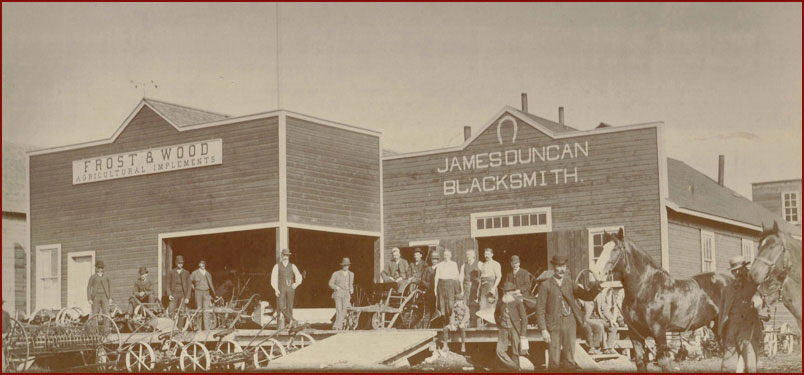James Duncan was born in Aberdeenshire,
Scotland in 1857, the son of James and Jane (Dalgamo) Duncan. Mr.
Duncan came to Canada in 1882 where he met Miss Helen McGuire, formerly
from England. They were married in Moffat, Saskatchewan in
1887. He homesteaded in Wolseley, Saskatchewan (N.W.T.) and also served
in the North-West Rebellion in 1885.
In 1888, Mr. Duncan settled in Melita. He worked at his blacksmith
trade before the town was incorporated. Later he established a farm
implement business and he was also associated with insurance.
Soon after the incorporation of Melita, he served on the town council
and rendered the community excellent service in this capacity. In other
ways he devoted his energies to the development of the town and
district. He was a member of the board of trade for many years and his
work as such, was recognized by his associates, who elected him to the
presidency.
He was a justice of the peace under the Greenway Government.
Mr. Duncan linked up with the I.O.O.F. in the early days of his career.
He was past noble grand of Melita Lodge No. 20, past grand master, and
past grand representative, attending the Grand Lodge at Atlanta,
Georgia, Indianapolis, Indiana and Winnipeg, while he was also past
chief patriarch.
Adapted from Our First Century, page 520

Photo from the Manitoba Archives
A Day in the Life of a Blacksmith
For the early settlers, the blacksmith was perhaps the most essential
tradesman. Not only did he make the iron parts for the
first farming implements, he also could repair all iron objects by
hammering them by hand on an anvil.
After heating the iron until white-hot, the blacksmith would then shape
and wield a multitude of objects from it, including
carriage bolts and wheels, iron work, cooking utensils, and most
importantly, horseshoes.
Blacksmiths who made horseshoes were called farriers, derived from the
Latin word for iron. At a time when horses were the
only means of transport, the blacksmith was important to not only
individual farmers and travelers. but also to merchants
whose businesses depended on transporting their goods to other places.
Also, because they spent much of their time shoeing
horses, blacksmiths gained a considerable amount of knowledge about
equine diseases.
The new industrial output of the late 1800s allowed the smith to
improve his shop. With a small boiler, steam engine, and a
system of overhead shafts, pulleys, and leather belts, the formerly
hand operated shop equipment like the post drill, the
blower, and other equipment could he easily powered. The small belt
powered machines like the Little Giant trip hammer
or its blacksmith built counterpart took its place in many small shops.
Later, the "steam" part of the steam driven leather belt
systems were replaced with small gasoline engines or electric motors.
In time, many power hammers were fitted with their own electric motors.
Many blacksmiths were manufacturers as well. Wagon boxes, the setting
of wagon and buggy tyres, lathe
turned parts for spinning wheels, the single bob manure sleigh, the
making of sleigh runners, bolsters, bunks and
tongues, and the custom manufacture of truck transfer boxes with cattle
hauling equipment were some of the items fabricated with finesse
befitting the labourers. Always, along with the aforesaid, there were
the innumerable interruptions to repair broken machinery as is wont to
happen in a mixed farming area.
|





